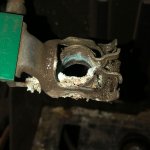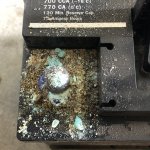Hi. My daughters 308 2Lt HDI occasionally generates smoke that exhausts from the front of the bonnet. It has done this several times now during a 12+ month period. Yesterday I was able to inspect the engine within 15 minutes of this occurring. The vehicle had been driven across town for 15 minutes, so when parked was at full operating temperature. As per previous occasions I could not identify a cause or source. The smoke smells like hot oil vapour. The engine is not overheating, There are no external oils leaks onto the ground. There are no external oil leaks on/around the engine, that I can see. The engine oil on the dipstick is approx 7mm overfull from the upper mark, but the smoke was occurring prior to the vehicle being serviced by a local mechanic, so I don't suspect the overfull sump as the cause. Vehicle has done 230,000km.
I suspect that engine oil is getting onto hot components and vapourising to smoke. It is difficult to gain access and to see in behind the engine where the exhaust and turbo are located. My second theory is that I have observed there is a fair bit of crankcase blowby & oil getting into the inlet plumbing to the turbo inlet. Once the engine is at operating temperature and the vehicle is parked, heat soaks across from the turbine to the compressor side of the turbo and the surface temperature is hot enough to fume/smoke the oil coating the wetted areas of internal plumbing. This then increase volume in the inlet duct and comes out via the air cleaner element. Then vents out the front of the bonnet area.
Does anybody have experience with these engines? Has anyone seen this occur?
I have a short MP4 video of the smoke, but can't attach this file.
I suspect that engine oil is getting onto hot components and vapourising to smoke. It is difficult to gain access and to see in behind the engine where the exhaust and turbo are located. My second theory is that I have observed there is a fair bit of crankcase blowby & oil getting into the inlet plumbing to the turbo inlet. Once the engine is at operating temperature and the vehicle is parked, heat soaks across from the turbine to the compressor side of the turbo and the surface temperature is hot enough to fume/smoke the oil coating the wetted areas of internal plumbing. This then increase volume in the inlet duct and comes out via the air cleaner element. Then vents out the front of the bonnet area.
Does anybody have experience with these engines? Has anyone seen this occur?
I have a short MP4 video of the smoke, but can't attach this file.


